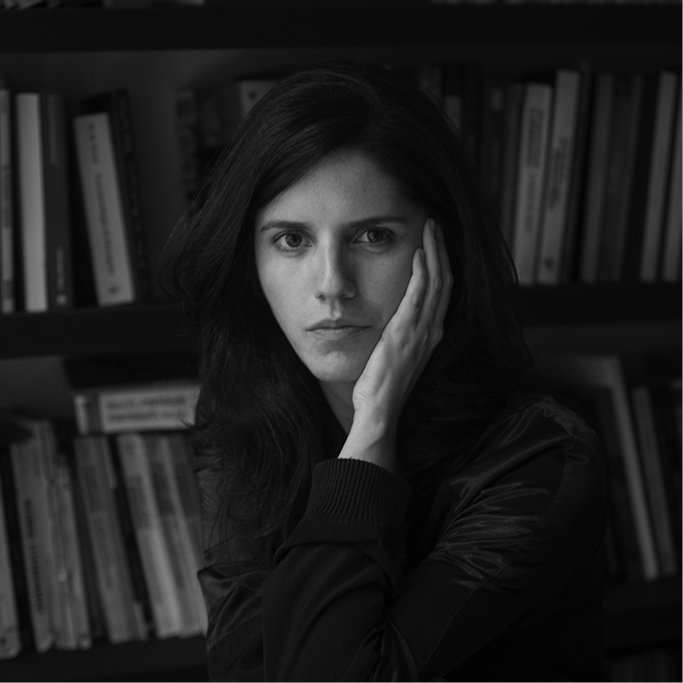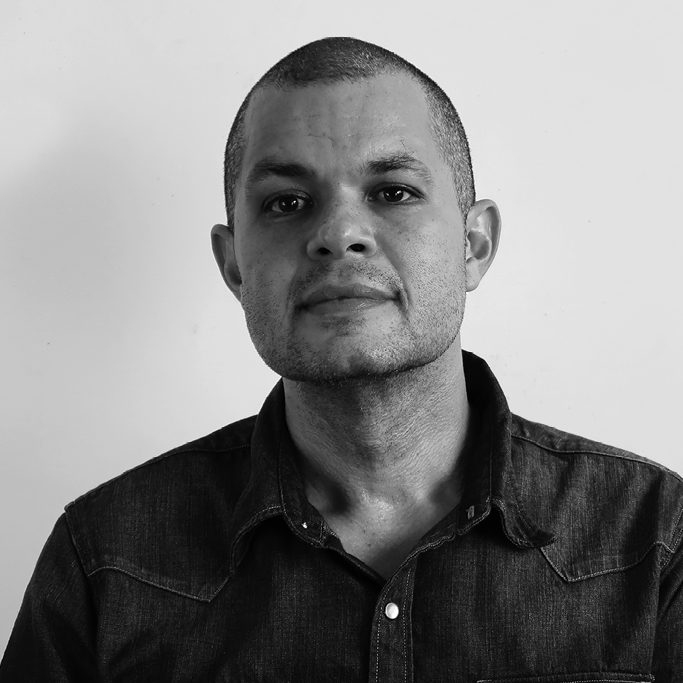There are two texts dedicated to Bang Bang. Keep reading for Luisa Duarte’s “The World before the Shot” or skip ahead to Guilherme Gutman’s “Stray Bullet”.
The World before the Shot
por Luisa Duarte
The first time I saw the sculptures by Raul Mourão where his famous Balanços (See-Saws) are balanced on different empty glass bottles, it was as if I were encountering something strangely familiar. The bottles played the role of an intruder in an unknown territory. The geometric sculptures built entirely from steel offered an unexpected sign of everyday life, with its own temperature and a fragility that was unprecedented at the time. This gesture, in my view, opened up a new perspective of meanings regarding a well-known aspect of the artist’s process: which is to say, a state of strangeness created within a familiar situation.
We know that in the Balanços, made purely from steel, the power is generated by the unlikely combination of weight and lightness, where the rigidity of the material is infected by the playful vibration of the movement. As has been observed, this meeting of opposites has as one of its causes the fact that these sculptures emerged from Raul’s drawings. In other words, in the genesis of these works, which are so secure and proud, one notes an experimental, unpredictable, risk-taking quality. It is from this unsuspected kinship between opposites that the strength of much of these works derives.
This poetic foundation, in a state of constant friction, encounters a matchless moment in the video Bang Bang (2017). Over the course of six minutes, six different sculptures forged from this combination of elements – the steel geometry and the glass bottle – have their most vulnerable part targeted by a direct shot. We don’t know where the attack comes from. One, two, three, four, five, six works have their bases shattered. In other words, what matters here is not the annihilation of a specific work but rather that we are made to think about the meaning of the successive repetitions of the same type of impact.
On incorporating the fire-arm into the piece, the theme of violence is restored to the artist’s work. We may recall that, for many years, Raul produced numerous works which made direct reference to the railings that populate urban centers, thus alluding to a visuality that embodies the fear of violence in Brazil’s big cities. In the words of Paulo Herkenhoff, these steel sculptures, produced from 2001, are about the “geometry of fear in a precise historical context.”
Raul has conceived and produced Bang Bang in the light of the events of 2017, when Brazilian contemporary art has become the target of a fascist rage that is plaguing Brazil, forcing us to witness countless cases of the censorship of freedom of expression.1 The video can thus be read as a response to a moment where art has become a target of violent forces. But it should be noted that Bang Bang in no way illustrates this situation, which would render it merely propagandist.
Firstly, he creates a poetic event characterized by concision. The bottle, the geometric steel form, the kinetic register incorporated there which places everything in tenuous balance: the artist creates a scene that is simultaneously playful and stern, emotional and sober, fragile and tough; a kind of hourglass that contains a time that could shatter at any moment. A meeting of opposites: the empty bottles full of memories that contain countless narrative possibilities and the metallic geometric forms closed in on themselves.
The attacks launched against each bottle, shown in slow motion, initiate a time without truce, the shattering of an (im)possible balance. Finally, the attacks directed against the field of art were not informed by any degree of critical consideration, but were primarily characterized by a desire for a complete silencing – the annihilation itself – of the discourse of the other, of he or she who is different. In other words, the direct shot of Bang Bang, whose author is anonymous, precisely replicates this relationship deprived of any attempt at reflection or dialogue.
If we pause the video at 24 seconds, a fraction before the first shot, only the soundtrack indicates that something serious and irreparable is about to occur; since Raul’s sculpture is nothing more than the proof of the possibility of power derived from a meeting of opposites. This visual declaration of a possible balance between different things – the universal geometric forms and the botch-job of the empty bottles – and the beauty derived therefrom is proof that, in the field of art, we possess the chance to daily embark on what, in the so-called real world, sometimes appears impossible to us.
While, there outside, everything seems irreconcilable, a war between deaf parties, the artist constructs an allegory about these somber times through what he does best: a translation of the experience of life guided by critical distance that does not allow this translation to be reduced to a mere illustrative gesture. In other words, his Bang Bang does indeed concern the violence inflicted on art, but it is also, simultaneously, a testament to the durability of art: proof of its capacity to address us, in the midst of a ‘bang bang’ with no end in sight; the declaration of a possible equilibrium where the power of life occurs precisely in the meeting of the different. If reality plunges us into a paralyzing nihilism, art can still preserve our capacity to imagine another possible world, closer to that evoked by the work of Raul Mourão before each shot.
1 In 2017, several art exhibitions were the target of censorship in Brazil.
Stray Bullet
or
“Do not allow poetry, in any circumstance”1
or
Ever since art has existed, there has been a desire to destroy art.
About a film by Raul Mourão.
by Guilherme Gutman
Waiting for what is about to happen is as – or even more – distressing than when the shot is fired. Then, without the benefit of the doubt, there is a strange comfort in knowing that the tragicomic act2 has inescapably happened.
Without knowing where the bullet is coming from, the greater – iconic – fear is that the bullet is faster than the camera.
Waiting for what is going to happen takes a long time; even if it doesn’t, since its time was measured by the still-born metre of the norms of our time.
The shot flies relentlessly. Sure of itself; inexorable, in an assertive movement; without doubts, like the gears of a locomotive. With no return. A machine shot.
There is no cry. The dim light of the studio indicates that it is early or late; foggy or calm, in the city.
Nobody runs, nobody shouts, nobody sees.
Everything happens after the shot is fired.
The shot cuts in half a synesthetic, sonic atmosphere, as in a film by Kubrick: Paths of Glory (1957), Dr. Strangelove (1964), The Shining (1980), Full Metal Jacket (1987), Eyes Wide Shut (1999).
The sound of the bottle when shattered by the bellicose bullet is different to that of the wave that explodes, deafeningly and intensely, on the city beach.
Bellicose bullet, gentle beast.
Dada bullet; bullet given to alliterations.
Bullet that shoots, that buzzes and brays; that scoffs and cracks.
Zoomorphic bullet; dog that bites.
Following the centrifugal movement of the many fragments of glass that pulverize the air, the bottle is already different.
Now the bottle is an irregular carpet of glass, on which the metal structure of the sculpture rests. Glass that offers itself as milk to the oxidized element; glass that is mixed with rust, that supports the metal that, a short time ago, the bottle supported.
The first impression is that the metal part of the kinetic work is preserved after the shot; but no. The disfigured bottle incorporates the work, through the violence of the cold, lead bullet that did not know how to also wait and sweetly dissolve, in its own process of oxidization.
The bottle that spins in its unique rhythm3 in its bottleneck; the pendulum of Raul’s kinetic sculptures remains alone, on stage, like the actors of the monologues of the giants of the theatre.
Do any of us know what it means to spin entirely alone, Like a rolling stone?4
The work that then drives Raul Mourão’s film is composed of the piece of metal, of the glass bottle and the effect of the projectile. The shot is fired. The bottle shatters. The metal part merely does a samba dance.
Raul has always been alert to the city where he lives; aware also of all the other cities, thinking about the ugly railings since 1988-89, which, since then, have grotesquely ornamented the buildings: excrescences, vegetation that somehow advertised Brazilian urban violence, particularly that of the city of Rio de Janeiro.
Observing the dynamic of the streets, the survival strategies, the signposts that the city confusingly presents and that suggest confused paths, Raul completes the circle by transforming the fluorescent vegetation, in a reverse move, back into excrescence.
On the transistor radio, the Walkman and the mp3, the shooters also die5, flashing their lead teeth6.
Did this make the news? Every day, like the newspaper headlines, coloured in red, covered by a black cloth7, that only “animal traction” can reveal.
Is there any consolation? Only Ivens Machado8.
Is there any hope? Only that which will come from the Bishop of the Rosary, on the day of final judgment9.
The bullet that was fired has a short life; like an insect that lives for only one day.
But there is no poetic license for the bullet that is fired; there is shock, fear and bewilderment.
All poetry could only have been written before or after its firing.
The bullet that leaves does not come back. The news comes back. The cry comes back.
After everything, the noise dissipates; silence in tense, urban muteness.
Ever since art has existed, there has been a desire to destroy art.
1 Socrates; Plato.
2 Comic in the sense adopted by Dante (1265-1321), in his Divine Comedy, in allowing mythology or historical dramas to discuss the lives of common people.
3 A kind of idiorrhythmia, in the conception of Barthes, in How To Live Together (course at the Collège de France, 1976-7).
4 Muddy Waters; Bob Dylan; Jimi Hendrix.
5 Billy Roberts; Jimi Hendrix; O Rappa.
6 Paulinho da Viola.
7 Repressão outra vez: eis o saldo (1968), by Antonio Manuel.
8 O Consolador – The Consoler (1979), reinforced concrete and glass.
9 Muro no fundo de minha casa – Wall at the end of my house (undated), wood, concrete and shards of glass.

